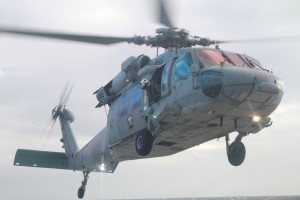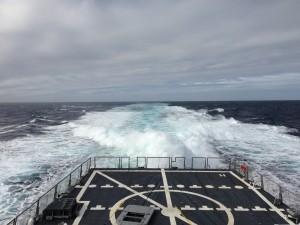































A career at Cisco provides us many amazing opportunities and experiences. As the SSEM for our Federal Navy Operation, I work alongside a world class team that serves our United States Navy, Marine Corps, and other DoD entities in the Pacific Rim (Hawaii, Japan, and Korea). On December 18, 2012 I had the privilege to participate in the United States Navy's "Leaders to Sea" program, which consists of embarks to/from various types of warships in the Navy's fleet. The purpose of these embarks is to give civilian leaders from various industries a first hand look at what life is like aboard a Navy ship, how the crew lives and works, and what general operations look like in real time, outside of the public eye. My particular embark was a day long event into and out of Naval Air Station North Island in Coronado, California aboard the USS Spruance, DDG-111. For those unfamiliar with classifications of the Navy's warships, "DDG"s are Guided Missile Destroyers. The Spruance is an Arleigh Burke Class Guided Missile Destroyer and is the second youngest DDG in the Navy's fleet, having been commissioned in October of 2011.
http://en.wikipedia.org/wiki/USS_Spruance_%28DDG-111%29
The day began at 06:00 hours meeting our contact, Senior Chief Petty Officer Robert Winkler at the truck gate entrance to Naval Amphibious Base Coronado (the West coast home of the Navy SEALs). After the seven people in my group arrived, we had a short briefing at the headquarters building for the commander of the Naval Surface Warfare Fleet. We were then transported across the island to Naval Air Station North Island to await our transport out to the Spruance, which was already underway a good distance off the coast of San Diego. I was excited to learn that we would be flying to the ship aboard a SH-60 Seahawk helicopter and landing on the aft helipad while the ship was underway. This was certainly a first for me. Our "helo" arrived and we had a briefing with the crew on our flight, the survival collars and gear we would be wearing, what to do in the event we had to ditch at sea, etc. My first laugh of the day came when I saw the expression on the faces of two others in the group that should we have to ditch, "wait for the helo to flip upside down, then hit the quick release, and climb/swim out...". They looked terrified, but the crew did a great job putting them at ease. We finished our briefing with instructions on how to enter/exit the helo and then were told to put our helmets and goggles on and follow the crew outside.

Once everyone was strapped in and after a short taxi to the designated helipads, we lifted off and began our trip out to the ship. We were told the weather wasn't ideal out at the ship and we might not be able to land (as they don't take chances with civilians on board if they don't have to). The weather was overcast and raining, but it was a light rain and our 45-minute flight was surprisingly smooth. Not having radios in our headsets, there was no communication from the crew so we didn't really know when we'd reach the ship. However, I felt us begin to descend and after a few short moments, I saw the wake of a ship down in the water and could tell we were on way down to the Spruance. After a few seconds, I saw the aft section of the ship and very noticeable sight of a helipad as it continued to cruise. We hovered very briefly and touched down amazingly smoothly and much quicker than I anticipated given the slightly rough seas. This crew (part of the "Blackjacks" squadron) made landing on a moving target with VERY little margin for error seem like a simple, routine event.

We then exited the helo and were lead inside one of the two helo hangars on the Spruance where we were greeted by the ship's captain, Commander George Kessler, and Ensign Joe Horn, the public affairs officer for the Commander Kessler (Ensign Horn's main duty was as a weapons officer). We met with Commander Kessler, his XO and Ensign Horn in the officer's ward room for a brief history of the ship, some specifics on Arleigh Burke Class destroyers, background on Admiral Spruance and why his name-sake was used for this ship. After that we began a tour of the entire ship, from standing on the bow next to the 5-inch gun and forward missile deck to walking to the aft section missile deck, viewing the Sea Whiz cannon and the devices that allowed them to resupply at sea. Then we went back inside the pressurized interior of the ship, down through the tiny ladder spaces to the engine room, mess hall, helo hangars, and generally every area of the ship except for the crew's living quarters. We avoided that area as there are always crew sleeping depending on watch/shift schedules and they don't want the crew to "feel like animals in a zoo".
The captain then hosted us to a lunch in the wardroom with each of the six department heads from the crew. We had a fantastic discussion centered on personnel development, training of the crew, attracting and retention of talented personnel, and even the ratio of male/female crew. We had an outstanding lunch and were then on to the most fun portion of the day.

We were taken to the bridge of the ship where we were each given an opportunity to literally drive the ship. We alternated manning the engine throttles, rudder control (the steering wheel) and the bridge wing watch/command. We went through three different man-overboard drills, using various combinations of sports-car type maneuvers, cutting across our own wake, and getting the ship turned around and a person out of the water in 8 minutes or less, though in these drills, no real people actually went overboard. The ship's captain then demonstrated a "crash-back", showing how the ship, at all engines full and at max speed, can stop and begin moving astern (in reverse) in the span of three ships lengths (approx. 1500 ft). Standing on the aft deck and watching the crash-back from up above the helipad was quite a site, but nothing was more interesting or fun than what we did next.



We stopped by the ward room to drop off all cameras, phones, etc. as no type of camera or recording devices are allowed in the combat center of the ship. I was the only person on in our group with an active security clearance, so the weapons officers had "scrubbed" the live screens and set up a training exercise for us. Each of us was lead to a different station, were seated, set up on "comms" and given some instructions on what our particular job was. We each had the actual duty officers for each station seated next to us to guide us through our portion of the exercise, which was a simulated attack on the ship from surface, sub-surface and air targets. I was seated in missile control, which meant as targets were identified as "enemy", orders to shoot those targets were sent to me. I would then confirm orders, lock the targets and actually fire the missiles or torpedoes, track them through impact and verify targets were destroyed. The exercise started slow, but once under full attack, it became very stressful and it gave me a new appreciation for the training and abilities these men and women possess to handle these situations with the utmost precision and skill.
After our turn in the combat systems room, we were told the weather was going to get worse and they wanted to send a helo to pick us up about an hour early to ensure we weren't all stuck on board for the night (though all of us would have gladly stayed aboard if given the chance). We gathered our things, finished our briefing with the captain and headed to the helo hangar to await our ride home. The helo arrived but had to circle for about twenty minutes waiting for a "green deck", which was the clearance from the ship's air controller to land. While the ship has the capability to land a helo in literally any sea-state and weather condition, as stated before, when civilians are aboard, they get very conservative and don't take unnecessary risks. We were literally about 4 minutes from being called off and staying aboard for the night when the helo finally got clearance to land. I watched it come in through a portal window in the exterior door and it was an awesome sight getting to see it land on a moving deck in the slightly rough seas. We were then given our flight gear by the helo crew and instructed to follow them out and get aboard. I was asked to sit in the port side gunner's window seat on the way back, which was fantastic. To get to fly off a ship and over the Pacific Ocean with a giant open window in front of me was a great way to end the exciting day. The flight back to N.A.S. North Island took about 40 minutes and after landing, we got a final debriefing and headed off on our way.


To see the men and women of our Navy and specifically, the crew of the USS Spruance in action was something I'll never forget. It made me especially proud not just of these young men and women, but of our Navy, our military and our country. It was such a shining example of how the United States and her Navy are truly the best in the world. I encourage anyone who has the opportunity to spend time with our military on any embark to do so. It's an experience that you will never forget.
A note about embark nomination process: The selection process can take from three months to three years starting from the time of nomination to vetting by the Navy and finally selection and embarkation to a ship at sea. Dennis Hall, founder of Avere Group LLC, made my embarking possible via my nomination. Dennis Hall initially submitted my nomination to the Public Affairs Officer of the US Navy Commander, Naval Surface Forces, Pacific. The Public Affairs Officer selected me for the Leaders to Sea Program.
Avere Group LLC URL for link:
www.AvereGroup.Wordpress.com
 Горячие метки:
Горячие метки: